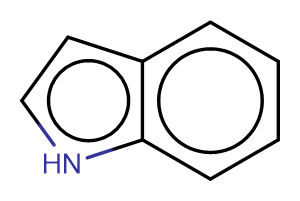
Indole
CAS No. 120-72-9
Indole( —— )
Catalog No. M19555 CAS No. 120-72-9
Indole is an aromatic heterocyclic organic compound. It has a bicyclic structure consisting of a six-membered benzene ring fused to a five-membered nitrogen-containing pyrrole ring.
Purity : >98% (HPLC)
 COA
COA
 Datasheet
Datasheet
 HNMR
HNMR
 HPLC
HPLC
 MSDS
MSDS
 Handing Instructions
Handing Instructions
| Size | Price / USD | Stock | Quantity |
| 100MG | 37 | In Stock |


|
| 200MG | Get Quote | In Stock |


|
| 500MG | Get Quote | In Stock |


|
| 1G | Get Quote | In Stock |


|
Biological Information
-
Product NameIndole
-
NoteResearch use only, not for human use.
-
Brief DescriptionIndole is an aromatic heterocyclic organic compound. It has a bicyclic structure consisting of a six-membered benzene ring fused to a five-membered nitrogen-containing pyrrole ring.
-
DescriptionIndole is an aromatic heterocyclic organic compound. It has a bicyclic structure consisting of a six-membered benzene ring fused to a five-membered nitrogen-containing pyrrole ring. It can be produced by bacteria as a degradation product of the amino acid tryptophan. It occurs naturally in human feces and has an intense fecal smell. At very low concentrations however it has a flowery smell and is a constituent of many flower scents (such as orange blossoms) and perfumes.
-
In Vitro——
-
In Vivo——
-
Synonyms——
-
PathwayOthers
-
TargetOther Targets
-
RecptorOthers
-
Research Area——
-
Indication——
Chemical Information
-
CAS Number120-72-9
-
Formula Weight117.15
-
Molecular FormulaC8H7N
-
Purity>98% (HPLC)
-
SolubilityEthanol: 100 mg/mL;Water: 2.8 mg/mL
-
SMILESc1cc2ccccc2[nH]1
-
Chemical Name1H-Indole
Shipping & Storage Information
-
Storage(-20℃)
-
ShippingWith Ice Pack
-
Stability≥ 2 years
Reference
1.Raw I et al. Catecholamines and congenital pain insensitivity. Braz J Med Biol Res. 1984;17(3-4):271-9.
molnova catalog



related products
-
Nordalbergin
Nordalbergin, a coumarin isolated from the wood bark of?Dalbergia sissoo. Nordalbergin shows strong activity in the induction of differentiation of HL-60.
-
euphol
Euphol an alcohol tetracyclic triterpene has a wide range of pharmacological properties and is considered to have anti-inflammatory action.
-
RP 61499
RP 61499 is an inactive isomer of aprikalim.



 Cart
Cart
 sales@molnova.com
sales@molnova.com


